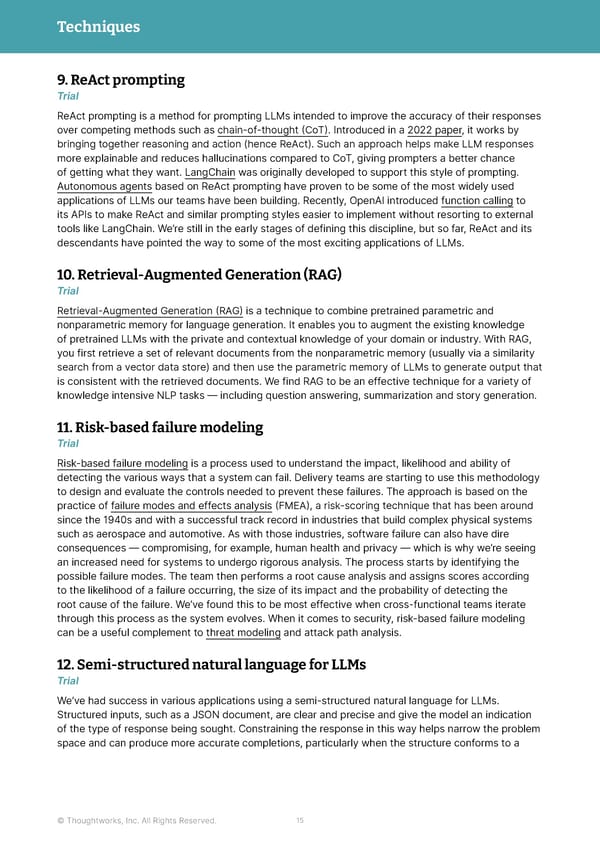Techniques 9. ReAct prompting Trial ReAct prompting is a method for prompting LLMs intended to improve the accuracy of their responses over competing methods such as chain-of-thought (CoT). Introduced in a 2022 paper, it works by bringing together reasoning and action (hence ReAct). Such an approach helps make LLM responses more explainable and reduces hallucinations compared to CoT, giving prompters a better chance of getting what they want. LangChain was originally developed to support this style of prompting. Autonomous agents based on ReAct prompting have proven to be some of the most widely used applications of LLMs our teams have been building. Recently, OpenAI introduced function calling to its APIs to make ReAct and similar prompting styles easier to implement without resorting to external tools like LangChain. We’re still in the early stages of defining this discipline, but so far, ReAct and its descendants have pointed the way to some of the most exciting applications of LLMs. 10. Retrieval-Augmented Generation (RAG) Trial Retrieval-Augmented Generation (RAG) is a technique to combine pretrained parametric and nonparametric memory for language generation. It enables you to augment the existing knowledge of pretrained LLMs with the private and contextual knowledge of your domain or industry. With RAG, you first retrieve a set of relevant documents from the nonparametric memory (usually via a similarity search from a vector data store) and then use the parametric memory of LLMs to generate output that is consistent with the retrieved documents. We find RAG to be an effective technique for a variety of knowledge intensive NLP tasks — including question answering, summarization and story generation. 11. Risk-based failure modeling Trial Risk-based failure modeling is a process used to understand the impact, likelihood and ability of detecting the various ways that a system can fail. Delivery teams are starting to use this methodology to design and evaluate the controls needed to prevent these failures. The approach is based on the practice of failure modes and effects analysis (FMEA), a risk-scoring technique that has been around since the 1940s and with a successful track record in industries that build complex physical systems such as aerospace and automotive. As with those industries, software failure can also have dire consequences — compromising, for example, human health and privacy — which is why we’re seeing an increased need for systems to undergo rigorous analysis. The process starts by identifying the possible failure modes. The team then performs a root cause analysis and assigns scores according to the likelihood of a failure occurring, the size of its impact and the probability of detecting the root cause of the failure. We’ve found this to be most effective when cross-functional teams iterate through this process as the system evolves. When it comes to security, risk-based failure modeling can be a useful complement to threat modeling and attack path analysis. 12. Semi-structured natural language for LLMs Trial We’ve had success in various applications using a semi-structured natural language for LLMs. Structured inputs, such as a JSON document, are clear and precise and give the model an indication of the type of response being sought. Constraining the response in this way helps narrow the problem space and can produce more accurate completions, particularly when the structure conforms to a © Thoughtworks, Inc. All Rights Reserved. 15
 Thoughtworks Technology Radar Page 14 Page 16
Thoughtworks Technology Radar Page 14 Page 16